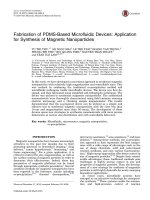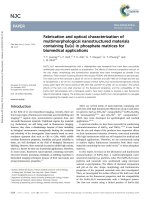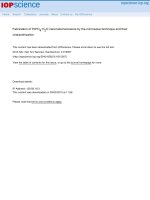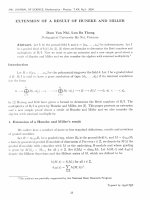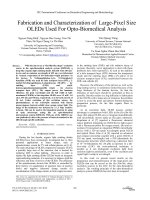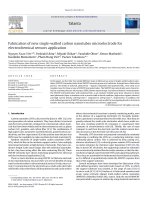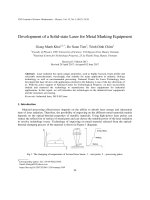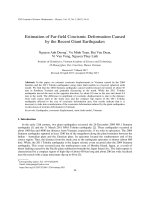DSpace at VNU: Fabrication of an antibacterial non-woven mat of a poly(lactic acid) chitosan blend by electrospinning
Bạn đang xem bản rút gọn của tài liệu. Xem và tải ngay bản đầy đủ của tài liệu tại đây (1.07 MB, 8 trang )
Macromolecular Research, Vol. 20, No. 1, pp 51-58 (2012)
DOI 10.1007/s13233-012-0010-9
www.springer.com/13233
Fabrication of An Antibacterial Non-Woven Mat of a Poly(lactic acid)/Chitosan
Blend by Electrospinning
Hang Thi Au1, Lan Ngoc Pham2, Thu Ha Thi Vu3, and Jun Seo Park*,1
1
Division of Chemical Engineering, Hankyong National University, Gyeonggi 456-749, Korea
2
Faculty of Chemistry, Hanoi University of Science, Hanoi, Vietnam
3
Vietnam Institute of Industrial Chemistry, Hanoi, Vietnam
Received April 19, 2011; Revised July 4, 2011; Accepted July 31, 2011
Abstract: Nonwoven mats made of a poly(lactic acid)/chitosan (PLA/CS) blend and a PLA/CS blend containing
silver (Ag) nanoparticles (Ag/PLA/CS) were prepared using an electrospinning technique. The morphology of electrospun fibers was observed by field emission scanning electron microscopy. The addition of AgNO3 to the PLA/CS
blend solution improved the electrospinning ability of the PLA/CS blend. The average diameters of the electrospun
PLA/CS and Ag/PLA/CS blend fibers decreased as CS content increased. The Ag particles were evenly distributed
in PLA/CS ultrafine fibers observed under transmission electron microscopy. Ag nanoparticles were spontaneously
generated during the electrospinning process. When the CS content in the blend increased, the size of the Ag nanoparticles on the surface of the electrospun fibers increased as well. The thermal and mechanical properties of the
nonwoven mats were examined by differential scanning calorimetry and a tensile tester. Fourier transform infrared
spectroscopy was used to characterize the molecular interactions among PLA, Ag, and CS in the blends. The antibacterial activity of the nonwoven mats against Escherichia coli and Staphylococcus aureus was studied using an
optical density method.
Keywords: chitosan, poly(lactic acid), silver nanoparticles, antibacterial activity, electrospinning.
Introduction
in solutions, CS cannot be fabricated easily in fiber form by
electrospinning.9,10 CS is brittle in film form, and its membrane permeability limits its use as a biomaterial.8 To overcome these shortcomings, many methods have been suggested
for improving the morphology and ductility of CS.8 One of
these methods is the preparation of blends consisting of CS
and a mechanically strong polymer such as polyvinyl alcohol (PVA), poly(ethylene oxide) (PEO), or poly(vinyl pyrrolidone) (PVP).11,12
There has been considerable interest in the blending of CS
with biodegradable polyesters; such blends could be used in
important human clinical applications approved by the US
Food and Drug Administration (FDA), e.g., in surgical
sutures and some implantable devices.1 Among the many
biodegradable polyesters, poly(lactic acid) (PLA) has attracted
the most attention because it is obtained through the synthesis of lactic acid, which is produced from renewable resources
such as corn and sugarcane. PLA is an enantiomeric polyester, including poly(L-lactic acid) (PLLA) and poly(D-lactic
acid) (PDLA), and has many useful characteristics such as
low toxicity, excellent biocompatibility, and good mechanical properties.13 In addition, it is known to facilitate the production of uniform e-spun nanofibers without bead
formation.14,15 PLA has been used with CS to prepare com-
Electrospinning is a simple and low-cost method for preparing ultrafine fibers with diameters ranging from several
micrometers to several hundreds of nanometers.1 The
electrospun (e-spun) fibers produced by this method show
great potential for a variety of biomedical applications, e.g.,
in the preparation of wound-dressing materials and tissueengineering scaffolds, because they have tunable porosity
and smaller pore size than traditional ones.2
Chitosan (CS), a (1-4)-linked-2-amino-2-deoxy-β-D-glucopyranose, is derived from chitin, which is the second
most abundant natural polysaccharide after cellulose.3,4 CS
displays an unique polycationic character, chelating in the
presence of active amino and hydroxyl functional groups.5-7
CS has been widely studied because it has many useful
properties such as, non-toxicity, biodegradability, and biocompatibility; further, it also shows haemostatic activity and
antibacterial properties.2 These characteristics render CS
beneficial for use in wound dressing, drug delivery systems,
vascular surgery, tissue culture, and various tissue engineering applications.5,8 However, due to its polycationic nature
*Corresponding Author. E-mail:
The Polymer Society of Korea
51
H. T. Au et al.
posite materials with improved toughness and with controllable biodegradability and chemical functionalities.8,16-18
A small amount of AgNO3 added to the PLA/CS blend
solution could improve its electrospinning ability since the
addition of AgNO3 was found to greatly change the morphology of the e-spun fibers from bead-on-fiber structure to
a uniform fiber structure.19 CS can react with AgNO3 to
reduce the repulsive force between ionic groups within the
polymer backbones.5-7,9,12 Thus, a continuous fiber can be espun from Ag+/PLA/CS solution with high concentration of
CS. Moreover, silver (Ag) nanoparticles have attracted great
interest because they show very strong antimicrobial activities.7,20 There are many methods for the reduction of Ag+ to
Ag nanoparticles.5,6,12,20,21 Ag+ can be reduced to Ag0 by
using a solvent as the reducing agent.20 The fabrication of
polymeric nanofibers containing Ag nanoparticles through
the heat treatment of e-spun nanofiber mats has also been
reported.7,21 In the Ag/PLA/CS blend solution, the release of
free silver ions from Ag+ by chitosan is more quick and
rapid.6 Ag nanoparticles are formed not only spontaneously
generated from Ag+ ions, but also by the reaction between
chitosan and silver nitrate during the electrospinning process.5,6,12 PLA/CS containing Ag nanoparticles are also produced by the heat-annealing of e-spun Ag+/PLA/CS blends
fibers. The reaction between CS and Ag+ contributes to the
change in average size and number of Ag nanoparticles on
the surface of fibers with and without heat treatment. The
antibacterial activity of CS incorporating with Ag is higher
than that of each component. Thus, AgNO3 can be added to
a PLA/CS blend to improve the electrospinning ability and
antimicrobial activities.
In the present study, e-spun PLA/CS blend fibers and espun Ag/PLA/CS blend fibers were fabricated by using the
electrospinning method. Field emission scanning electron
microscopy (FE-SEM) was used to study the effects of CS
and AgNO3 on the microstructure of the e-spun PLA/CS
and Ag/PLA/CS blend fibers. The formation and shape of
the Ag nanoparticles on the surface of the PLA/CS fiber
was observed by transmission electron microscopy (TEM)
to examine the influence of the concentration of CS in the
blend on the size of Ag particles. Differential scanning calorimetry (DSC) was employed to study the thermal properties of the e-spun fibers. The mechanical properties of the espun PVA/CS blend fibers were evaluated using a tensile
tester. Fourier transform infrared (FTIR) spectroscopy was
used to investigate the molecular interactions between PLA,
silver, and CS in the blends. The antibacterial properties of
the e-spun PLA/CS and Ag/PLA/CS blend fibers were
examined using the optical density method.
Experimental
Materials. CS (Mv=693,840; degree of deacetylation=
90%) was obtained from the Bio Materials Co. (Korea).
52
PLA (Mv=71,210) was purchased from Acros Organics
(USA). The molecular weights of PLA and CS were obtained
by using the solution viscosity measurement method. The
intrinsic viscosities of PLA and CS were measured with an
Ubbelohde viscometer at 25 oC in chloroform and 0.1 M
HOAc - 0.2 M NaCl, respectively.22-25 Trifluoroacetic acid
(TFA) and silver nitrate (AgNO3) were purchased from the
Samchun Chemical Co. (Korea).
Measurement of Viscosity and Ionic Conductivity. The
ionic conductivities of the PLA/CS blend solutions were
determined using a conductivity meter (HI 2300, Hanna
instruments, Korea) under an ambient atmosphere. The viscosity of each solution was measured using a viscometer
(LVDVII, Brookfield USA). The solution was first placed
into the viscometer chamber, and then into a water jacket.
Viscosity measurements were conducted using a #18 cylindrical spindle under an ambient atmosphere.
Electrospinning. PLA and CS were dissolved in TFA at
various weight ratios: PLA/CS=100/0, 70/30, 50/50, and
30/70. The total concentration of PLA and CS was 10 wt%.
Silver nitrate (2 wt%) was added to the PLA/CS blend
solution to prepare the Ag/PLA/CS blend by electrospinning.
Electrospinning of the polymer blend solution was performed at room temperature, with a voltage of 12 kV, and a
tip-to-collector distance of 10 cm. The spinning rate was
approximately 0.3 mL/h. Each of the prepared solutions was
stored in a standard 5-mL plastic syringe attached to a blunt
20-gauge stainless steel hypodermic needle. The flow rate
of the polymer solution was controlled by a syringe pump.
A high supply voltage was connected to the hypodermic
needle, which was used as a positive electrode.
Heat-Annealing. The non-woven mats of the PLA/CS
blend containing silver nanoparticles were heated in an
oven at 100 oC for 15 h.
Instrumentation. The morphology of the non-woven
mats was observed by FE-SEM using a HITACHI S-4700
(Japan) with a BAL-TEC MED_020 coating system. A
Tecnai_G2 TEM with carbon-coated copper grids was used
to observe the Ag nanoparticles on the surface of the e-spun
fibers.
The thermal behavior of the non-woven mats of the PLA/
CS blends and Ag/PLA/CS blends was investigated by DSC
(TA Instruments, USA). The melting behavior of the nonwoven mats was examined by heating at a rate of 10 oC/min
under a nitrogen flow.
The mechanical properties of the non-woven mats of the
PLA/CS blend were determined using a Lloyd testing
machine (Lloyd Instruments., UK). The non-woven mats
were tested with a 0.1 N preload at a cross-head speed of
5 mm/min. The average values from three repetitions were
taken as the tensile strength and the elongation at break.
Antibacterial Assessment. The antibacterial properties
of the non-woven mats of PLA/CS and Ag/PLA/CS blends
were determined against Escherichia coli (E. coli) and StaMacromol. Res., Vol. 20, No. 1, 2012
Fabrication of An Antibacterial Non-Woven Mat of a Poly(lactic acid)/Chitosan Blend by Electrospinning
phylococcus aureus (S. aureus) by using the optical density
method. Difco Nutrient Broth and Brain Heart Infusion
were used as the media for the E. coli and S. aureus,
respectively. These media were used as the negative
controls. A representative bacteria colony (0.1 mL) was
cultivated in 9.9 mL of nutrient broth. The bacterial solution
was used as the positive control. The non-woven mats of the
PLA/CS and Ag/PLA/CS blends were put into the solution,
and then shaken at 37 oC for 8, 16, 24, and 36 h, respectively.
The weight of the non-woven mats of the PLA/CS or Ag/
PLA/CS blends was 10 mg. After incubation, 0.2 mL of the
solution was removed and put into 96-well plates. The
turbidity of the solutions was measured at 600 nm with a
UV spectrophotometer (Shimadza UV-vis spectrometer,
Japan).26,27
Results and Discussion
Viscosity and Ionic Conductivity Measurements. The
solution viscosity and ionic conductivity of the AgNO3/
PLA/CS blend solutions and PLA/CS blend solutions were
measured for various concentrations of CS, as shown in
Figure 1. It was found that the viscosity of the polymer solutions increase with an increasing CS content in the blends.
This occurred because the viscous chitosan solution had a
positive effect on the blend viscosity. However, the effect of
silver nitrate on the viscosity of the polymer solutions was
not pronounced (as shown in Figure 1(a)-(b)).
Figure 1(c)-(d) show the ionic conductivities of the
AgNO3/PLA/CS and PLA/CS blend solutions. It was found
that the ionic conductivity of PLA/CS blend solutions
increased with increasing CS concentration (as shown in
Figure 1. Effect of CS concentration on the viscosity of the
AgNO3/PLA/CS blend (a), PLA/CS blend (b), on the ionic
conductivity of the AgNO3/PLA/CS blend (c), and PLA/CS
blend (d).
Macromol. Res., Vol. 20, No. 1, 2012
Figure 1(d)). This tendency is attributed to the polycationic
nature of CS in the polymer blend solution. When CS was
dissolved in the TFA solution, the -NH2 of the CS became
-NH3+. Therefore, the -NH3+ groups increased with increasing the concentration of CS in the PLA/CS blend solutions.
The same trend was observed for the case of the Ag+/PLA/
CS blend solutions (as shown in Figure 1(c)). Comparison
of the results between line (c) and line (d) in Figure 1, when
the concentration of CS was higher than 40 wt%, the ionic
conductivities of the AgNO3/PLA/CS blend solutions are
lower than those of the PLA/CS blend solution for the same
PLA/CS weight ratios in the blend. In AgNO3/PLA/CS
blend solutions, the amine and hydroxyl groups of chitosan
play important role in uptake of silver cations by chelation
mechanism.6 This indicates that Ag+ can interact with CS to
inhibit the ionizability of the amino group of CS through a
chelating mechanism.5,6
Morphology of e-Spun PLA/CS Blend Fibers and eSpun Ag/PLA/CS Blend Fibers. Figure 2 shows FE-SEM
micrographs of the e-spun PLA fibers and e-spun PLA/CS
blend fibers. The average diameter of the e-spun PLA/CS
blend fibers decreased from 572 to 239 nm with an increase
in the content of CS from 0 to 70% in the blends. Figure 2
shows that the non-woven mats of the e-spun fibers exhibited an uniform fibrous structure at the PLA/CS weight
ratios of 100/0 and 70/30. When the concentration of CS in
the blends was increased to a ratio of PLA/CS=50/50, beads
were observed in the non-woven mat (as shown in (c) in
Figure 2). The e-spun fibers could hardly be formed at all
when the CS content in the polymer blend was equal to or
higher than PLA/CS=30/70 (as shown in (d) in Figure 2).
These behaviors can be explained by supposing that, as the
concentration of polycationic CS in the blend increased, the
Figure 2. FE-SEM micrographs (average diameter (Dave) and
diameter distribution) of e-spun fibers of PLA/CS non-woven
mats with different weight ratios of PLA to CS: (a) 100/0, (b) 70/
30, (c) 50/50, and (d) 30/70.
53
H. T. Au et al.
Figure 3. FE-SEM micrograph (average diameter (Dave) and
diameter distribution) of e-spun fibers of Ag/PLA/CS blend nonwoven mats with different weight ratios of PLA to CS: (a) 100/0,
(b) 70/30, (c) 50/50, and (d) 30/70.
repulsive force between the ionic groups within the polymer
backbone also increased, resulting in no formation of e-spun
fibers at higher concentrations of CS in the blend solution.
As the concentration of CS in the blend solution increased,
the average diameter of the e-spun fibers of the PLA/CS
blend decreased, and their diameter distribution became
slightly narrower. Since chitosan is an ionic polyelectrolyte,
during electrospinning of the blend sample, a higher charge
density on the surface of ejected jet is formed. As the
charges carried by the jet increase, higher elongation forces
are imposed on the jet under the electric field. This is
because the electric field force is proportional to the charge
density on the jet, thus resulting in a decreased fiber diameter with an increase in charge density.11,28
Figure 3 shows FE-SEM micrographs of e-spun PLA
fibers containing silver nanoparticles, and e-spun PLA/CS
blend fibers containing Ag nanoparticles. The average diameters of the e-spun fibers of Ag/PLA/CS were 361, 338, 297,
and 195 nm for CS concentrations of 0, 30, 50, and 70%
in the blends, respectively. Comparison of Figures 3 and 2
shows that the diameters of the e-spun fibers of Ag/PLA/CS
of Figure 3 also decreased as the CS content increased. For
ratios of PLA to CS from 50/50 to 30/70, a good fibrous
structure was observed in the e-spun Ag/PLA/CS blend
fibers (as shown in (c) and (d) in Figure 3), whereas the espun PLA/CS blend fibers form beads, and are hard to form
at the same weight ratios of PLA to CS (as shown in (c) and
(d) in Figure 2). This can be explained by considering that
the repulsive forces between the ionic groups within the CS
backbone were decreased by adding a small amount of salt,
as the amine groups of CS interacted with the Ag cations
through a chelation mechanism.6 Therefore, the addition a
small amount of salt improved the electrospinning ability of
54
Figure 4. TEM micrographs of e-spun fibers of the Ag/PLA/CS
blend before heat-annealing with different weight ratios of PLA
to CS in the blend solution: (a) PLA/CS=100/0, (b) PLA/CS=70/
30, (c) PLA/CS=50/50, and (d) PLA/CS=30/70.
the PLA/CS blend solutions.
Figure 4 shows TEM micrographs of the e-spun PLA/CS
blend fibers containing silver nanoparticles with different
PLA/CS weight ratios before heat-annealing. The Ag nanoparticles on the surface of the e-spun fibers are spherical,
with diameters of 1.08, 1.69, 3.18, and 9.47 nm for CS contents of 0%, 30%, 50%, and 70% in the blends, respectively.
A large number of Ag nanoparticles were observed on the
surface of the e-spun PLA/CS blend fibers. This indicates
that Ag nanoparticles were generated during the electrospinning process. In effect, Ag nanoparticles could be generated easily and grown on the surface of the metallic part
when a metallic needle and an electrode were employed
for the electrospinning of polymer blend solutions.21 Ag
nanoparticles can be fabricated from Ag+ ions during electrospinning.7,21 The average size of the Ag nanoparticles
increased, but their number decreased, with increasing CS
concentration in the polymer blend solution. An explanation
may be that the CS can enclose and combine the Ag nanoparticles through coordination interactions between the amino
and hydroxyl groups of CS and the Ag ions.5,6 Ag nanoparticles were also generated spontaneously during the electrospinning process, and their size increased but their number
decreased with increasing CS content in the blend solution.
Figure 5 shows TEM micrographs of the e-spun Ag/PLA/
CS blend with different PLA to CS weight ratios after heatannealing at 100 oC for 15 h. Comparing the results of Figures 5 and 4, it is seen that the average size of the Ag nanoparticles on the surface of the e-spun fibers tended to
Macromol. Res., Vol. 20, No. 1, 2012
Fabrication of An Antibacterial Non-Woven Mat of a Poly(lactic acid)/Chitosan Blend by Electrospinning
Figure 5. TEM micrographs of e-spun fibers of the Ag/PLA/CS
blend with different PLA to CS weight ratios after heat-annealing
at 100 oC for 15 h: (a) PLA/CS=100/0, (b) PLA/CS=70/30, (c)
PLA/CS=50/50, and (d) PLA/CS=30/70.
increase, and their number decreased, when the concentration of CS was increased. The average diameter of the Ag
nanoparticles on the surface of the PLA e-spun fibers
increased from 1.08 to 2.74 nm after heat-annealing. At the
same weight ratios of PLA/CS in the blends, the sizes of the
Ag nanoparticles on the surface of the e-spun PLA/CS
blend fiber also increased with heat-annealing, but the number of Ag nanoparticles decreased. The Ag nanoparticles on
the surface of the e-spun fiber were still spherical, and were
evenly distributed on the surface of the PLA/CS blend
fibers after heat-annealing. This can be explained by considering that the Ag+ ions and Ag nanoparticles on the surface
of the PLA fibers, which are residual during the electrospinning process, can diffuse and aggregate to form larger Ag
nanoparticles during the heat-annealing process.7 In the espun fibers of the Ag/PLA/CS blend, the residual Ag+ ions
and Ag nanoparticles not only aggregated during the heatannealing process, but also combined with CS to form
larger Ag nanoparticles, thus reducing the number of Ag
nanoparticles in the e-spun fibers. This indicates that the
size of the Ag nanoparticles can be increased by increasing
the concentration of CS or by the heat- annealing process.
DSC Analysis. Figure 6(A) and (B) show DSC thermograms
of the e-spun PLA/CS blend fibers and e-spun PLA/CS
blend fibers containing Ag nanoparticles with different
weight ratios of PLA to CS in the blends, respectively. PLA
and PLA/CS blends show an endothermic curve with peak
of melting and slope of glass transition of PLA. PLA and
PLA with silver nanoparticles have quite similar melting
Macromol. Res., Vol. 20, No. 1, 2012
Figure 6. (A) DSC thermograms of: (a) PLA nanofibers, (b)
PLA/CS 70/30 nanofibers, (c) PLA/CS 50/50 nanofibers, and (d)
PLA/CS 30/70 nanofibers. (B) DSC thermograms of: (a) Ag/
PLA nanofibers, (b) Ag/PLA/CS 70/30 nanofibers, (c) Ag/PLA/
CS 50/50 nanofibers, and (d) Ag/PLA/CS 30/70 nanofibers.
point around 152 oC indicating no difference in thermal
properties by the presence of silver nanoparticles in the
PLA formed during electrospinning. Endothermic curves of
the PLA/CS blends and PLA/CS blends containing silver
nanoparticles became broader and more obtuse with
increasing CS concentration. The endothermic heat (Hm) in
the thermogram curves of the PLA/CS blend decreased with
the inclusion of CS in the blends. CS is amorphous polymer
and interferes the formation of crystal structure of PLA in
the PLA/CS blend. Multi peaks in the endothermic curve of
PLA/CS blends in Figure 6(A) and (B) were observed
indicating different crystalline structures of PLA in the
PLA/CS blends, which were formed during electrospinning.
The presence of rigid CS in the PLA/CS blends may affect
the formation of crystalline structure of PLA in the process
of nucleation and crystallization. Amorphous CS also retards
the rate of crystallization and makes imperfect crystal
structure of PLA.2,29 Figure 6(A) shows that the slope of
endothermic curves of PLA around 59 oC indicating Tg of
PLA increased with content of CS in the PLA/CS blends.
CS is known to have very rigid structure with glass
transition temperature (Tg) of 203 oC.29 This indicates there
is some partial miscibility between PLA and CS in the PLA/
55
H. T. Au et al.
Figure 7. FTIR spectra of non-woven mats of e-spun fibers of
PLA/CS blends for different weight ratios of PLA to CS: (a)
PLA/CS=100/0, (b) PLA/CS=70/30, (c) PLA/CS=50/50, (d)
PLA/CS=30/70, and (e) CS.
CS blends.30,31 Tg of blend nanofibers of PLA/CS of 30/70
was not observed in Figure 6(A) showing no crystal of PLA
was formed in the PLA/CS blend fibers. Figure 6(B) shows
that Tg of the PLA nanofibers containing silver nanoparticles
has a slight higher value than that of PLA nanofibers. The
presence of silver nanoparticles in PLA nanofibers might
influence the mobility of PLA main chains lowering the Tg
of PLA. Tgs of PLA/CS blends containing silver were not
observed in Figure 6(B). This is attributed to the combined
effect of silver nanoparticles and rigid CS in the PLA/CS
blends.
FTIR Spectra. Figure 7 shows the FTIR spectra of nonwoven mats of the e-spun fibers of PLA/CS blends with different weight ratios of PLA to CS. It is found that the e-spun
fibers of CS present strong bands at 1673 and 1532 cm-1,
which are characteristic of the amide I and II absorption
bands, respectively. In addition, the weak peak at 1376 cm-1
is the characteristic of the amide III band of the CS vibration (see line (e) in Figure 7). The FTIR spectrum of PLA
(see line (a) in Figure 7) displays characteristic absorption
bands at 1755, 1188, and 1089 cm-1, which are attributed to
the backbone ester group of PLA.1 As seen in lines (b), (c),
and (d) in Figure 7, the relative strength of the peak at 1755
cm-1, which is attributed to the carbonyl group of PLA,
decreased with increasing CS content in the PLA/CS
blends, whereas the relative strength of the peak at 1673 cm-1,
which is identified as the absorption of the amide I of CS,
increased. This behavior could be rationalized by the fact
that PLA does not have enough -OH groups to form hydrogen bonds with the -OH and -NH2 groups of CS. Therefore,
the specific interaction between CS and PLA is weak.1,14
Figure 8 presents the FTIR spectra for non-woven mats of
the e-spun fibers of PLA/CS blends with and without silver
56
Figure 8. FTIR spectra of non-woven mats of PLA/CS blends
with and without silver; (a) PLA, (b) Ag/PLA, (c) PLA/CS (50/
50), (d) Ag/PLA/CS (50/50), and (e) CS.
nanoparticles. Comparing the results of e-spun Ag/PLA/CS
blend and e-spun PLA/CS blend fibers, it is found that the
amide I and II bending vibration bands at about 1673 and
1532 cm-1 of Ag/PLA/CS blend decreased significantly in
intensity (see lines (c) and (d) in Figure 8). There was no
difference in the FTIR result between the PLA and Ag/PLA
blends. The difference in the FTIR spectra between PLA/
CS and Ag/PLA/CS blends is attributed to the attachment of
silver to the nitrogen atoms, which reduces the vibration
intensity of the N-H bond.5
Tensile Tests. The mechanical properties of the polymer
blends depend on many factors, including the structure of
the blends and the interactions between each polymer component in the blends.12,14 The mechanical strengths of nonwoven mats of the e-spun fibers of PLA/CS blends are
shown in Figure 9. CS is known to be a very brittle and rigid
natural polymer, whereas PLA is a tough natural polymer.
Figure 9 shows that, for the non-woven mats of e-spun
fibers of the PLA/CS blend with the weight ratio 90/10, the
tensile strength at break is higher than that of PLA, whereas
the elongation at break is lower. With the increase of rigid
CS content in the blends, the tensile strength at break
increased, whereas the elongation at break decreased, as
seen in lines (b), (c), and (d) in Figure 9. This indicates that
the combination of mechanically strong PLA and weak CS
increases the possibility e-spun PLA/CS blends being used
in various applications.
Antibacterial Test. Figure 10(A) and (B) show the result of
the optical density (OD) versus culture time for the nonwoven mats of e-spun fibers of PLA/CS and Ag/PLA/CS
blends against E. coli and S. aureus, respectively. The bacterial cell was opaque, and as the bacteria propagated the bacterial solutions became turbid. Hence, the antibacterial
activity of the non-woven mats of the e-spun fibers could be
Macromol. Res., Vol. 20, No. 1, 2012
Fabrication of An Antibacterial Non-Woven Mat of a Poly(lactic acid)/Chitosan Blend by Electrospinning
OD of the Ag/PLA/CS blend is much lower than that of the
PLA/CS blend for both E. coli and S. aureus. The OD of the
Ag/PLA/CS non-woven mats is lower than that of the Ag/
PLA non-woven mat. This indicates that the antibacterial
activity of CS incorporating Ag (silver ions or nanoparticles) is higher than that of each of the components. Thus,
the presence of Ag nanoparticles in the e-spun fibers of the
PLA/CS blend can significantly increase the antibacterial
activity.
Conclusions
Figure 9. Stress-strain curves of non-woven mats of the e-spun
fibers of PLA/CS blends with different PLA/CS weight ratios: (a)
100/0, (b) 90/10, (c) 80/20, and (d) 70/30. The non-woven mats
of the e-spun fibers were tested with a 0.1-N preload at a crosshead speed of 5 mm/min.
Figure 10. OD versus culture time for the (a) medium, (b) PLA,
(c) PLA/CS 70/30 non-woven mat, and (d-g) Ag/PLA/CS blend
non-woven mat with different weight ratios of PLA/CS against
E. coli (A) and S. aureus (B) (The weight ratios of PLA to CS in
(d)-(g) are 100/0, 70/30, 50/50, and 30/70, respectively).
measured using optical density as the criterion. The higher
the antibacterial activity of the non-woven mats, the smaller
the OD of the solutions.26,27,32 As observed from Figure 10(A)
and (B), the OD of the PLA/CS (70/30) is much lower than
that of the PLA non-woven mat. In the non-woven mats of
the e-spun fibers of the Ag/PLA/CS blend, the OD decreased
with increasing CS content for both bacteria E. coli and S.
aureus. In other words, the antibacterial activity of the blend
non-woven mats was enhanced when the CS concentration
was increased, thus demonstrating the antibacterial activity
of the CS in the blends to both: E. coli and S. aureus. Comparison of the OD results for the PLA/CS and Ag/PLA/CS
blends at weight ratios of PLA/CS of 70/30 shows that the
Macromol. Res., Vol. 20, No. 1, 2012
Non-woven mats of e-spun fibers of PLA/CS blends and
PLA/CS blends containing Ag nanoparticles were fabricated by using the electrospinning method. PLA and AgNO3
can improve the electrospinnability of the CS. The mechanical
properties of CS and its suitability for electrospinning can
be improved by blending it with PLA and AgNO3. The
results of FTIR indicated that the molecular interaction
between CS and PLA is not strong and silver is attached to
the nitrogen atoms of CS. Ag nanoparticles were spontaneously generated in the PLA/CS blends during the electrospinning process. When the CS content was increased and
heat-annealing of the blends was carried out, the size of the
Ag nanoparticles increased, while the number of particles
decreased. It was found that in Ag/PLA/CS blend, the size
of Ag nanoparticles was controlled not only by the content
of CS but also by heat-annealing. The CS in the PLA/CS
blend exhibited a good antibacterial activity against the
gram-negative bacteria E. coli and the gram-positive bacteria S. aureus. The antibacterial activity of PLA/CS blends
containing silver nanoparticles was much better than those
of PLA/CS blends and Ag/PLA. The e-spun antibacterial
PLA/CS/Ag blend is promising for various uses in the medical sector, e.g., in wound-healing applications.
References
(1) J. Xu, J. Zhang, W. Gao, H. Liang, H. Wang, and J. Li, Mater.
Lett., 63, 658 (2009).
(2) M. Ignatova, K. Starbova, N. Markova, N. Manolova, and I.
Rashkov, Carbohydr. Res., 341, 2098 (2006).
(3) S. Torres-Giner, M. Ocio, and J. Lagaron, Eng. Life Sci., 8,
303 (2008).
(4) W. K. Son, J. H. Youk, and W. H. Park, Carbohydr. Polym.,
65, 430 (2006).
(5) D. Wei, W. Sun, W. Qian, Y. Ye, and X. Ma, Carbohydr. Res.,
344, 2375 (2009).
(6) K. G. G. V. Natarajan, S. S. Han, K. S. Nahm, and Y. S. Lee,
Iran. Polym. J., 18, 383 (2009).
(7) W.-J. Jin, H. J. Jeon, J. H. Kim, and J. H. Youk, Synth. Met.,
157, 454 (2007).
(8) C. Chen, L. Dong, and M. K. Cheung, Eur. Polym. J., 41, 958
(2005).
(9) W. H. Park, L. Jeong, D. I. Yoo, and S. Hudson, Polymer, 45,
57
H. T. Au et al.
7151 (2004).
(10) S. Torres-Giner, M. J. Ocio, and J. M. Lagaron, Carbohydr.
Polym., 77, 261 (2009).
(11) Y.-T. Jia, J. Gong, X.-H. Gu, H.-Y. Kim, J. Dong, and X.-Y.
Shen, Carbohydr. Polym., 67, 403 (2007).
(12) J. An, H. Zhang, J. Zhang, Y. Zhao, and X. Yuan, Colloid
Polym. Sci., 287, 1425 (2009).
(13) S.-L. Yang, Z.-H. Wu, W. Yang, and M.-B. Yang, Polym.
Test., 27, 957 (2008).
(14) N. Suyatma, A. Copinet, L. Tighzert, and V. Coma, J. Polym.
Environ., 12, 1 (2004).
(15) H. Tsuji, A. Mizuno, and Y. Ikada, J. Appl. Polym. Sci., 77,
1452 (2000).
(16) X. Zhang, H. Hua, X. Shen, and Q. Yang, Polymer, 48, 1005
(2007).
(17) F. Sébastien, G. Stéphane, A. Copinet, and V. Coma, Carbohydr. Polym., 65, 185 (2006).
(18) M. Peesan, P. Supaphol, and R. Rujiravanit, Carbohydr.
Polym., 60, 343 (2005).
(19) X. Zong, K. Kim, D. Fang, S. Ran, B. S. Hsiao, and B. Chu,
Polymer, 43, 4403 (2002).
(20) E. Kim, S. Kim, and C. Lee, Macromol. Res., 18, 215 (2010).
(21) K. H. Hong, J. L. Park, I. H. Sul, J. H. Youk, and T. J. Kang,
J. Polym. Sci., 44, 2468 (2006).
58
(22) W. P. Ye, F. S. Du, W. H. Jin, J. Y. Yang, and Y. Xu, React.
Funct. Polym., 32, 161 (1997).
(23) P. van de Witte, P. J. Dijkstra, J. W. A. van den Berg, and J.
Feijen, Polym. Phys., 34, 2553 (1996).
(24) L. Fang, R. Qi, L. Liu, G. Juan, and S. Huang, Int. J. Polym.
Sci., 2009, 7 (2009).
(25) E. J. Mark, Polymer Data Handbook, Oxford University
Press, New York, 1998.
(26) Z. Li, X. P. Zhuang, X. F. Liu, Y. L. Guan, and K. D. Yao,
Polymer, 43, 1541 (2002).
(27) H. V. Tran, L. D. Tran, C. T. Ba, H. D. Vu, T. N. Nguyen, D.
G. Pham, and P. X. Nguyen, Colloids Surf. A: Physicochem.
Eng. Asp., 360, 32 (2010).
(28) U. S. Sajeev, K. A. Anand, D. Menon, and S. Nair, Bull.
Mater. Sci., 31, 343 (2008).
(29) K. Sakurai, T. Maegawa, and T. Takahashi, Polymer, 41, 7051
(2000).
(30) X. Shuai, Y. He, N. Asakawa, and Y. Inoue, J. Appl. Polym. Sci.,
81, 762 (2001).
(31) N. E. Suyatma, A. Copinet, L. Tighzert, and V. Coma, J.
Polym. Environ., 12, 1 (2004).
(32) B. Son, B. Y. Yeom, S. H. Song, C. S. Lee, and T. S. Hwang,
J. Appl. Polym. Sci., 111, 2892 (2009).
Macromol. Res., Vol. 20, No. 1, 2012
